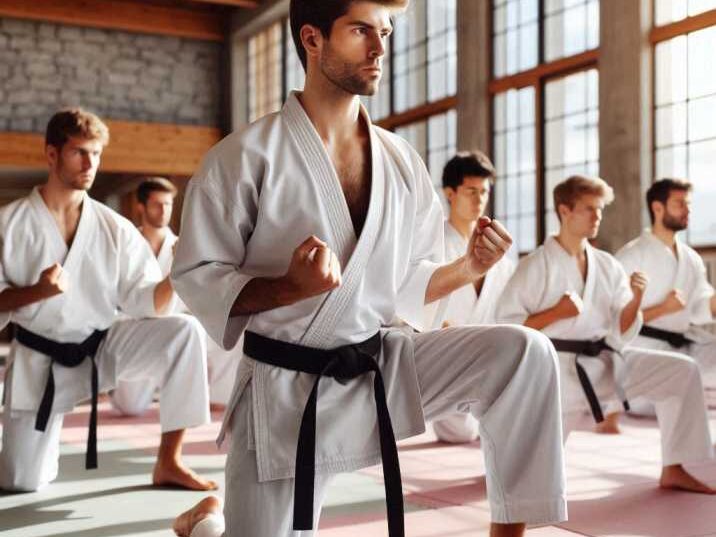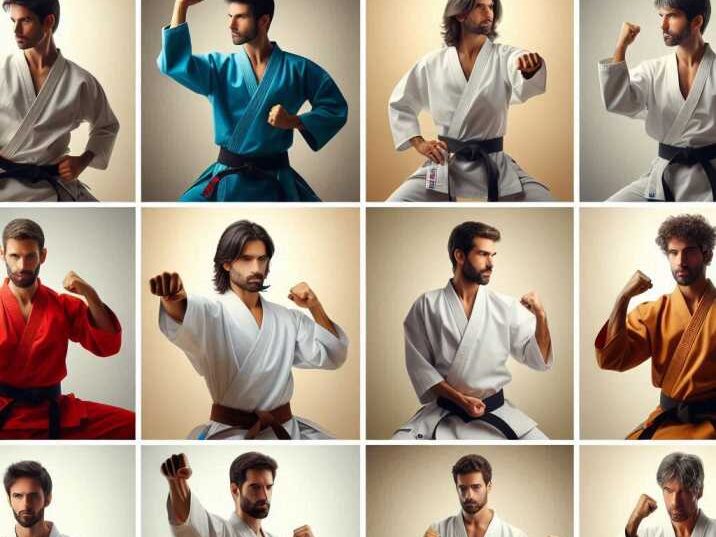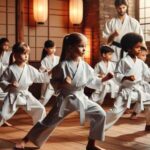Karate is one of the most well-known martial arts in the world, combining physical strength with mental discipline. Karate training can help improve focus, build confidence, and teach self-defence. There are several different styles of karate, each with its unique moves and traditions. In this article, we’ll explore the 10 main types of karate and their key features. Whether you’re a beginner or an experienced martial artist, understanding these styles can help you choose the one that’s right for you.
Introduction
Table of Contents
Karate is more than just a way to defend yourself—it’s a form of physical training that also strengthens the mind. It originated in Japan, and over time, different styles of karate developed, each emphasizing different techniques and philosophies. In this article, we’ll focus on the 10 main types of karate, breaking down what makes each one special. We’ll also discuss how karate can help improve focus, discipline, and even school performance, which is great for young students.
Types of Karate
1. Shotokan Karate
Shotokan karate is one of the most popular and recognizable styles. Developed by Gichin Funakoshi, it focuses on powerful and precise movements. This style is known for its deep stances and strong punches and kicks. The emphasis is on both mental and physical development, making it a well-rounded style for students of all ages.
- Key Focus: Speed and form
- Techniques: Strong punches and kicks, low stances, rapid movements
- Benefits: Improves coordination, builds muscle strength, and enhances focus.

Why It’s Popular:
Shotokan karate’s focus on speed and perfect form makes it ideal for those looking to improve their coordination and agility. The strong emphasis on focus and discipline also helps students become better at concentrating in other areas of life, such as school.
2. Goju-Ryu Karate
Goju-Ryu karate is a balanced style that combines both hard and soft techniques. It was founded by Chojun Miyagi and is known for its deep breathing exercises and fluid movements. Goju-Ryu focuses on blending aggressive attacks with defensive techniques, making it both powerful and graceful.
- Key Focus: Strength and flexibility
- Techniques: Circular blocks, quick strikes, deep breathing exercises
- Benefits: Increases endurance and reduces stress through controlled breathing
Why It’s Special:
The combination of hard strikes and soft, fluid movements makes Goju-Ryu karate unique. The focus on controlled breathing helps to reduce stress and build endurance, which are beneficial both inside and outside the dojo.
3. Shito-Ryu Karate
Shito-Ryu karate is a versatile style that combines two older forms of karate, Shorin-Ryu and Shorei-Ryu. This style is all about speed and adaptability. Students learn to perform a wide range of strikes and defensive moves, making it useful for both self-defence and competition.
- Key Focus: Speed and versatility
- Techniques: High kicks, fast punches, dynamic combinations
- Benefits: Improves agility and teaches a wide range of moves for self-defence
Why It Stands Out:
Shito-Ryu’s focus on speed and versatility makes it perfect for students looking to master a broad range of techniques. This style is especially great for self-defence, as it teaches students how to react quickly and effectively.
4. Wado-Ryu Karate
Wado-Ryu karate emphasizes the art of evasion. Unlike other styles that focus on meeting force with force, Wado-Ryu teaches students to avoid attacks and redirect an opponent’s energy. It incorporates elements of jujutsu, a Japanese martial art focused on joint locks and throws.
- Key Focus: Evasion and timing
- Techniques: Dodges, light strikes, redirection of energy
- Benefits: Builds reflexes and teaches non-confrontational conflict resolution
Why It’s Different:
Wado-Ryu is ideal for students who want to avoid confrontation. By focusing on evasion and timing, this style helps practitioners become quicker and more aware of their surroundings.
5. Kyokushin Karate
Kyokushin karate is known for its full-contact sparring and rigorous physical conditioning. It was developed by Masutatsu Oyama, and its training sessions are intense. Kyokushin karate promotes mental toughness as well as physical strength, making it one of the more physically demanding karate styles.
- Key Focus: Strength and endurance
- Techniques: Powerful kicks, low stances, close-range fighting
- Benefits: Builds physical toughness and mental resilience
Why It’s Tough:
Kyokushin karate’s emphasis on strength and endurance makes it a popular choice for students who are looking for a challenging workout. The tough training sessions help build both physical toughness and mental resilience.
6. Uechi-Ryu Karate
Uechi-Ryu karate has deep roots in Okinawa and is heavily influenced by Chinese martial arts. This style focuses on conditioning the body to withstand strikes and is designed for real-world self-defense.
- Key Focus: Conditioning and self-defense
- Techniques: Close-range strikes, joint locks, toughening exercises
- Benefits: Teaches real-world self-defence skills and builds durability
Why It’s Practical:
Uechi-Ryu karate’s focus on self-defence and body conditioning makes it extremely practical. The toughening exercises help students build durability, preparing them to face real-life confrontations.
7. Shorin-Ryu Karate
As one of the oldest styles of karate, Shorin-Ryu karate emphasizes speed, agility, and lightness. Its techniques are sharp and quick, with a focus on evasive maneuvers.
- Key Focus: Speed and precision
- Techniques: Fast, high kicks, quick punches, evasive maneuvers
- Benefits: Improves agility and quick thinking
Why It’s Fast:
Shorin-Ryu karate’s emphasis on speed and precision makes it a good style for students who want to be light on their feet. Its techniques focus on evasive maneuvers to avoid an opponent’s attacks.
8. Chito-Ryu Karate
Chito-Ryu karate is a blend of ancient Chinese and Okinawan martial arts. This style focuses on balance—both in physical movements and in the mental approach to training.
- Key Focus: Balance and form
- Techniques: Mid-range kicks, balanced stances, defensive techniques
- Benefits: Builds body control and mental focus
Why It’s Balanced:
Chito-Ryu karate’s strong emphasis on balance makes it ideal for students who want to develop both physical and mental stability. The style’s emphasis on form and defensive techniques is perfect for those looking to build body control.
9. Isshin-Ryu Karate
Isshin-Ryu karate is a modern style that simplifies many traditional techniques, making it easier for students to learn quickly. Developed by Tatsuo Shimabuku, Isshin-Ryu focuses on efficiency and directness.
- Key Focus: Efficiency and speed
- Techniques: Quick punches, straight-line movements, upright stances
- Benefits: Easy to learn and adaptable for real-life self-defense situations
Why It’s Efficient:
Isshin-Ryu karate’s focus on efficiency makes it a practical style for beginners and advanced students alike. Its techniques are direct and easy to apply in real-world situations.
10. Enshin Karate
Enshin karate focuses on circular movements and close-range fighting. It’s designed specifically for self-defence, using an opponent’s momentum against them. This style emphasizes the redirection of energy rather than meeting an opponent’s force head-on.
- Key Focus: Circular motion and redirection
- Techniques: Sweeps, low kicks, grappling moves
- Benefits: Perfect for self-defence and learning to control an opponent’s movement
Why It’s Strategic:
Enshin karate’s focus on using circular motion and redirection makes it a strategic style for self-defence. The emphasis on close-range techniques and controlling an opponent’s movement is ideal for real-world scenarios.
Table of Information
| Karate Style | Key Focus | Techniques | Benefits |
|---|---|---|---|
| Shotokan | Speed and form | Strong punches, low stances, rapid movements | Improves focus, builds strength |
| Goju-Ryu | Strength and flexibility | Circular blocks, deep breathing | Increases endurance, reduces stress |
| Shito-Ryu | Speed and versatility | High kicks, fast punches, dynamic combinations | Builds durability, teaches real-world defence |
| Wado-Ryu | Evasion and timing | Dodges, light strikes, redirection of energy | Builds reflexes, teaches conflict resolution |
| Kyokushin | Strength and endurance | Powerful kicks, low stances, close-range fighting | Builds toughness, mental resilience |
| Uechi-Ryu | Easy to learn, adaptable for self-defence | Close-range strikes, joint locks, toughening | Conditioning and self-defence |
| Shorin-Ryu | Speed and precision | High kicks, quick punches, evasive maneuvers | Improves agility and quick thinking |
| Chito-Ryu | Balance and form | Mid-range kicks, defensive techniques | Builds body control and focus |
| Isshin-Ryu | Efficiency and speed | Quick punches, straight-line movements | Perfect for self-defence, controlling opponents |
| Enshin | Circular motion and redirection | Sweeps, low kicks, grappling moves | Perfect for self-defense, controlling opponents |

Conclusion
Karate has evolved into many different styles, each offering its approach to learning and mastering the martial art. Whether you’re looking to improve your strength, agility, or mental focus, there’s a style of karate for you. From the powerful movements of Shotokan to the quick evasion techniques of Wado-Ryu, each style brings something unique to the world of martial arts.
FAQ
- What is the most popular karate style?
- Shotokan karate is the most popular style worldwide.
- Is karate good for self-defence?
- Yes, many karate styles like Goju-Ryu and Wado-Ryu are excellent for self-defence.
- Can kids learn karate?
- Absolutely! Karate is great for teaching discipline, focus, and physical fitness to children.
- How long does it take to master karate?
- Mastering karate can take years of dedicated practice, but most people see significant improvements within the first year of training.
- Which karate style is the hardest?
- Kyokushin karate is considered one of the most physically demanding styles due to its intense training and full-contact sparring.


